Phone: 03 577 2395
C/- Marlborough Research Centre Trust, PO Box 875, Blenheim 7201


In this issue:
The NZDFI team has completed a regional strategy looking out to 2030: ‘Durable eucalypts: A multi-regional opportunity for New Zealand’s drylands’.
The strategy sets out what NZDFI aims to achieve towards developing regional industries based on high-value durable eucalypts.
Focus areas for NZDFI’s ongoing R&D programme have been identified as follows:
Actions/goals for NZDFI’s programme have been planned within each of our six focus areas that can be achieved with funding under the FGR/MBIE Special Wood Products partnership until this ends in June 2022.
In addition, further actions/goals have been identified that require additional funding if they are to be achieved in the next three years and beyond.
Read the full strategy document here.
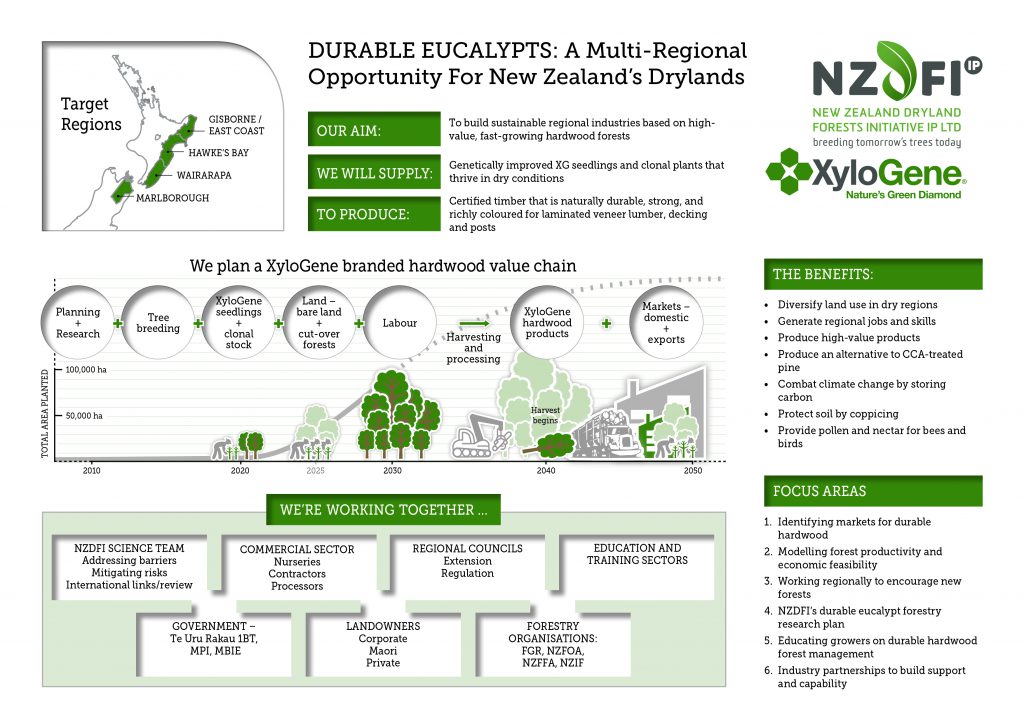
Durable eucalypts produce timber of relatively high stiffness, even at young age. This is good news for producers of engineered wood products such as Laminated Veneer Lumber (LVL), who are looking for an alternative to radiata pine because radiata products do not meet the high stiffness standards increasingly required by the construction industry.
A recent trial by the Wood Science team at the University of Canterbury School of Forestry involved rotary peeling of 15-year-old E. bosistoana and E quadrangulata logs at Nelson Pine Industries (NPI) in Richmond. Logs were peeled, and the veneers returned to UC for analysis.
Results were encouraging, indicating for example that the E. bosistoana veneer would out-perform radiata in terms of stiffness as predicted. In future the use of spindle lathes for the peeling process could greatly enhance veneer recovery from small logs. Some spindle lathes peel logs to leave a core, which could be marketed as a ground durable post. Other lathes can handle smaller logs, but there would be no bi-product of a post from the core of each log.
The next phase of research at UC will look at suitable gluing techniques for the eucalyptus veneers.
Read the full report of the peeling trials here.
(Contributor: Clemens Altaner)
The NZDFI breeding population of E.bosistoana is divided into three distinct sets of open-pollinated families planted in breeding populations (progeny trials) over three years (2009, 2010 and 2012). A total of 198 families were established in these trials.
In addition to the progeny trials, short term trials of the breeding population were established in a nursery environment at Woodville. These were planted at 1.0m spacing and felled at age 1-2 years with small stem samples collected and used to measure growth-strain and other wood property traits in very young trees.
In 2014, the top twelve families were identified based on growth and form data collected in the 2009 progeny trials at age 4.5 years at the trials at MDC Cravens Rd and Lawsons in Marlborough. The best individual tree from each of these 12 families was located in the trials and a collection of scion material undertaken by Proseed. This was grafted and established in a clonal seed orchard at Amberley in 2016.
Following that first selection of ortets from among the families planted in 2009, growth and form assessments were completed in the 2010 breeding populations during 2016-2017. During the same period, over 4,000 cores were collected from all families in the 2009 and 2010 breeding populations and these were used to evaluate heartwood percent and extractive content using NIR.
Data collected in the 2009 and 2010 progeny tests have been used to derive family breeding values for growth, form, heartwood percent and extractive content along with data on growth strain collected from the nursery study of these families at Woodville. This has resulted in additional elite families for Proseed’s clonal seed orchard being identified.
Identified among the families planted in the 2010 trials were 4 families with positive breeding values for growth (measured by dbh), straightness and form, heartwood and extractive content, and growth strain. In February 2019, each tree remaining in the 2010 trial at MDC Cravens Rd of the top ranked families was located and the best individuals among these were marked. A collection of scion material was undertaken by Proseed for grafting onto potted rootstocks of E. bosistoana seedlings.
An additional five trees from the MDC Cravens Rd 2009 progeny tested families were also selected based on high heartwood content and low growth strain recorded at the Woodville trial and scions were collected for grafting.
Assessments of the breeding populations established in 2012 at sites in Marlborough, Wairarapa and Hawkes Bay are a priority to broaden the base of the current deployment population represented in Proseed’s clonal seed orchard.
(Contributor: Ruth McConnochie)
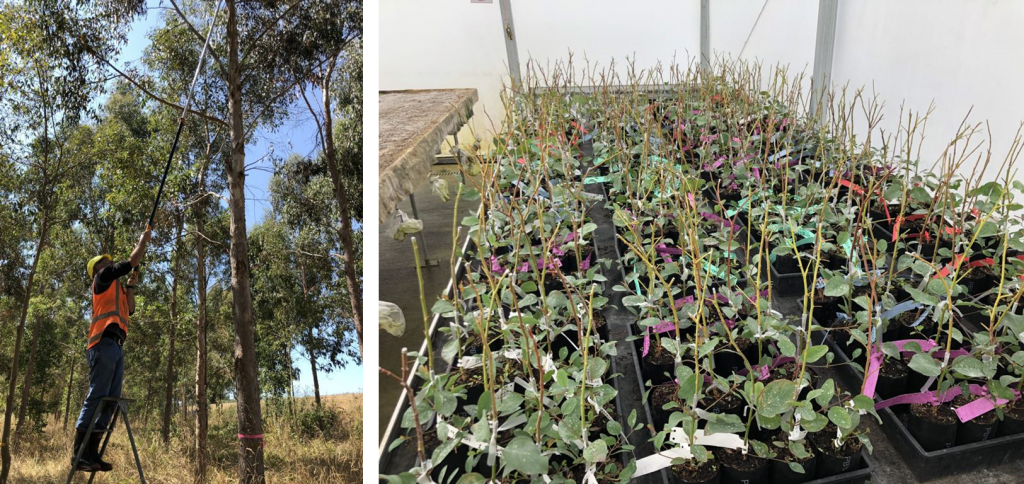
The collection of scions from the elite trees at the Cravens Rd trial site (left) and completed grafts in the poly house at Proseed, Amberley (right).
The AgMardt-funded project, ‘Matching elite high-value eucalypts to drylands’, is now complete.
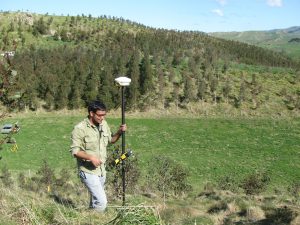
Serajis Selakin at work in McNeill's trial the Hawke's Bay.
The project aimed to establish hybrid physiological/mensurational yield models for durable dryland eucalypt species and to connect microsite variation with larger scale variation in site influences on tree species.
Meteorological stations were established at seven NZDFI trial sites, and a total of 113 plots were measured. Soil moisture and temperature loggers were stablished on three sites where high resolution estimates of microsite influences were conducted. In addition, detailed soil surveys at two intensively monitored sites were conducted during the second half of 2015.
Digital elevation models (DEMs) were created at two sites using transects of points with a high resolution global positioning system, demonstrating the viability of this technique for sites with poor LiDAR coverage.
The research demonstrated that more understanding of local variation in tree performance could be gained from highly accurate DEMs than from intensive soil sampling on these sites. The predominant influences were wind exposure, represented by a wind exposure index from the DEMs, position index, distance from the top of a ridge line, and morphometric protection, also calculated from the DEMs.
Juvenile yield models were created for two eucalypt species, covering both local and global site variables. A growth and yield model was created for E. globoidea, for which rotation-length data were available.
Key outcomes of the project
Much of the work on this project was undertaken by Dr Serajis Selakin, from Bangladesh. Serajis’ PhD was based on this work. His thesis ‘Hybrid growth models for E. globoidea and E.bositoana: Explaining within and between site variability’ is available here.
(Contributor: Euan Mason)
‘During the last six months I have spent a lot of time in the field, collecting data. My most recent fieldwork was in the Okuti Valley, Canterbury, where I worked in a 29-year old Eucalyptus globoidea stand.
Thirty one trees were harvested and their taper was analysed. In addition, 315 discs were collected. These were analysed to provide the taper data of heartwood. Finally, all the standing trees were GPS-located for future analysis of environmental effects on heartwood formation.
Back in the office, I have been working on modelling taper and volume, using the collected data and statistical tools and software.”
Watch Daniel's video about his work
“Over the past six months I have assessed the Atkinson E. globoidea breeding trial by coring over 2000 trees (Figure 1). Heartwood quantity can be measured from the cores (Figure 2) and durability predicted by assessing extractive content with NIR (Near Infrared Spectroscopy) (Figure 3).
I also detected cellular collapse during drying of some of the core samples, an undesirable wood property trait. I have been able to quantify the variation of this trait within and between families (Figure 4). It is worth noting that collapse was absent in the thousands of E. bosistoana cores previously obtained in the NZDFI breeding programme.
I also worked with the NZDFI team and JNL contractors to collect 100 samples each from the top and the bottom of coppice regrowth in the Atkinson trial (Figure 5). The samples were assessed for growth strain and other wood properties (stiffness, acoustic velocity, volumetric shrinkage, density and diameter) measurement.
I also assessed the wood properties of a two year old E. quadrangulata breeding trial planted at Murray’s Nursery in Woodville. There was only weak correlation between diameter and growth strain, but this was enough to enable the best families to be selected.
NZDFI’s focus is to identify high performing genetic material in a widespread network of breeding trials. Selection for tree health as tolerance to browsing damage is significant for a productive plantation estate. A crucial factor can be the chemical composition of the leaves, which might be
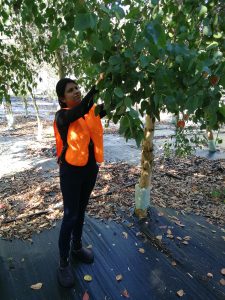
Collecting samples from the Harewood plantation, Christchurch.
easier to assess than browsing damage. Better understanding of the phytochemical composition will also test the potential of essential oils as a by-product of the naturally durable timber plantations, potentially contributing to the profitability of such plantations. Hence, my PhD is focused on the following objectives:
I have started to collect leaf samples from the Harewood plantation near Christchurch to identify the annual variation of essential oil content and composition in young and old leaves. A total of five families, including three trees in each, were selected and the sampling has been done each month since March 2019.
Total essential oil content varied from 6.3 µl/g-13.5 µl/g throughout the period in mature leaves and in young leaves it ranged from 8.3 µl/g-17.5 µl/g. Oil levels are mainly correlated with the composition of 1,8- cineole. The 1,8-cineole composition in old and young leaves ranged from 50%-74% and 43%-63% respectively.
--------------------------------------------------------------------------------------------------------------------------------------------------------
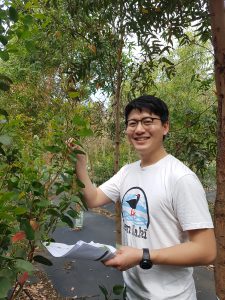
“My PhD research the University of Canterbury is a genomic and taxonomic study of Eucalyptus species using SNP data to inform future genomic selection in breeding programs. Additionally, I am interested in resolving the taxonomic delimitation of two morphologically similar species (E. argophloia and E. bosistoana).
Over the past six months I have been working on my research proposal and undertaken a full literature review.
My three main research questions are:
To answer the first question, I aim to clarify morphologically intermediate characteristics of the two species using morphometrics, and interpret these with genomic data.
Work on the second question will help increase genetic gain by providing information about patterns of genetic diversity to the Breeder’s Equation.
Answering the last question will inform efficient selection by improving our understanding of the breeding system of the species in the NZDFI breeding program.
My research will use a Single Nucleotide Polymorphism (SNP) chip for detecting polymorphisms within a population. The University of Canterbury has joined the Eucalyptus 65kSNP Axiom array production and deployment initiative (ESAI) to develop an improved version of a high‐throughput SNP genotyping system. We contributed 24 DNA samples (12 of each species), and the customized SNP chip is currently being developed.
In February and March 2019, EVB incidence and paropsine defoliation were assessed at two NZDFI E. bosistoana breeding trials, Ngaumu (Wairarapa) and McNeil (Hawkes Bay). It was found that EVB has yet to cause damage at Ngaumu; only a very small number of beetles and 1 batch of larvae were found at the site, total paropsine feeding damage was light. Damage that was present was mostly restricted to adjacent E. quadrangulata.
At McNeil’s, where EVB has been established since 2016, 889 trees were assessed. Defoliation attributable to paropsine beetles were observed across the site. A large population of EVB adults was present, and Paropsis was also present as adults and larvae in much lower numbers. It is not possible to determine with 100% certainty which of these species caused the damage. All 80 E. bosistoana families assessed sustained highly variable levels of damage, with individual trees sustaining 5-90% defoliation of the upper one third of the crown. Some individual trees within 52 of the 80 families suffered >80% defoliation. However, at least some trees from each of 39 families sustained <10% defoliation. Average defoliation per family ranged from 27% to 63%. Families from certain provenances (i.e. seed collected from multiple trees within a particular region in Australia) suffered significantly less defoliation on average compared to other provenances. This backs up the results previously observed in a similar assessment of 17 E. bosistoana families in Marlborough.
Although it is disappointing to see substantial defoliation of some tree crowns, the high degree of variation is positive. If this variation result from heritable traits this gives us something to use in the breeding programme to improve either pest resistance, or more importantly pest tolerance (coping with insect defoliation without too much impact on growth.
The presence of many predatory Cleobora mellyi adults, and small numbers of Harlequin ladybirds (Halmus chalybeus) were also noted during tree assessment both in January and March.
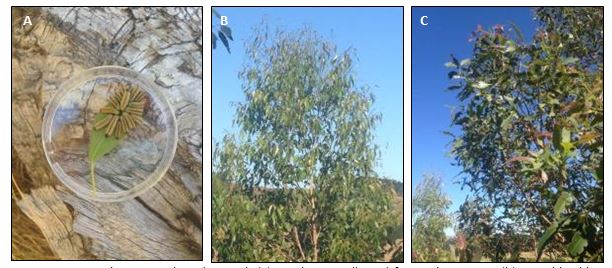
Ngaumu, 2012 E. bosistoana breeding trial; (a) EVB larvae collected from E bosistoana, (b) typical healthy E. bosistoana crown, (c) paropsine chewing damage to adjacent E. quadrangulata crown.
Southwards spread
EVB was detected in the South island, near Nelson, for the first time in January 2019. Inspection of E. bosistoana branches felled for collection of scion material at Cravens Rd, Marlborough, revealed two EVB adults. This represents the first observation of EVB in Marlborough and the southern-most detection to date. Both beetles were found in plots along the road edge, and on trees from ‘southern’ provenance families which have previously been observed to be more heavily attacked by Paropsis in Marlborough than other families assessed. Neither of the trees from which the beetles were collected were heavily defoliated at the time and crown health was generally very good across the whole trial.
New PhD student
A new PhD student, Leslie Mann, will commence her PhD studies in August 2019 at the University of Canterbury focusing on insect pests of durable eucalypts. Leslie comes from Switzerland where she completed her MSc at the University of Neuchâtel. Her research compared plant responses to slug versus insect herbivores by assessing the volatile defence compounds emitted by 16 common crop cultivars when under herbivore attack. This background in plant defensive chemistry will be extremely useful in understanding the attractiveness of different eucalypt species and genotypes to insect defoliators. Leslie has indicated she is keen to work with growers to provide practical and environmentally sustainable solutions for pest management.
(Contributor: Tara H. Murray)
The ‘Minimising Growth Strain’ project, funded by MPI’s Sustainable Farming Fund, is now complete.
Initially a three-year project, the work was extended by a further year so that further screening work could be undertaken.
The objectives of this project were to:
The project was embedded in a larger effort aiming to establish a sustainable durable timber resource in New Zealand. The outcomes of this project achieved key requirements towards this goal. Superior genotypes with lower growth-strain have been identified and are now commercially available through clonal propagation from coppice (see Item 3 in this newsletter). The potential and the main obstacles (i.e. gluing) of durable eucalypts for LVL production have been demonstrated.
PhD candidate Nick Davies is now completing his thesis, based on this work.
(Contributor: Clemens Altaner)
Propagation at Proseed for the NZDFI has been focused on several projects:
E. argophloia selections
Thirteen E. argophloia families were planted in a growth strain trial at Woodville.
The two best individuals, ranked on diameter and strain indexes, were sought from each family. In the event 13 high ranking clones were collected from 8 families. These will be planted into an archive at Amberley.
E bosistoana grafting and orchard establishment
In February 20 grafts were completed from each of 17 new clones collected from the Cravens Road progeny trial. Two hundred and forty ramets were produced and that included representation of every clone selected.
The E.bosistoana orchard at Amberley is partially complete with 15 clones that were the best individuals selected in 2014 from the 12 families planted in the Cravens Road and Lawsons progeny trials. Along with a few additional grafts completed last summer from best performers in the Woodville growth strain trials, there is now sufficient planting stock to finish planting the orchard, including rogueing of a few early selections that have not maintained ranking in the latest assessments.
Last summer, treatment of the existing E. bosistoana orchard with paclobutrazol produced a bumper flower crop but then there was rapid and extensive damage by Tortricid moth larvae (Strepsicrates macropetana) to developing seed capsules. Next season flowering will be monitored very closely with possible control options including pheromone traps, Bacillus thuringiensis kurstaki (BTK); multi-inhibitors (Neem derivatives that interfere with larval instar development); and insecticides. Particular care will be required to avoid harming bees and other insect pollinators.
E. bosistoana cuttings
From a short list of 50, 10 clones have been selected on a balance of growth and ease of propagation for bulking up and commercial distribution. Bulking of stool plants will begin in spring.
E. quadrangulata cuttings
Sustainable Farming Fund (SFF) milestones for E quadrangulata included capture of the top 1% of trees in the Woodville growth strain trial for industrial cutting propagation. The brief for Proseed was to root the four best clones from each of the top 21 families. An excellent result was achieved with 75 clones propagated from 18 of the top families. These will be bulked further during the coming summer.
E. globoidea grafting
E. globoidea has consistently proven difficult to graft. Best takes have never been more than 50% despite research into alternative practices. Never-the-less, sufficient ramets have been accumulated to consider establishment of a full seed orchard.
Next season
The main thrust of next summer’s work will be to establish E. bosistoana and E. quadrangulata stools for further propagation. Further development of cutting propagation techniques will be incorporated into this work. E. bosistoana and E. globoidea rootstock will be raised in anticipation of collecting further E. bosistoana selections this summer and continuing work to improve the E. globoidea grafting technique.
In November 2018 a clonal test of over 3,000 plants using cuttings of E. bosistoana was established at two Marlborough locations. The cuttings were propagated by Proseed NZ in their new facility in Amberley.
After a hot dry summer an assessment recorded 70% survival at one site while there was 100% survival at the other. Weed control was completed at the site with the losses, and clones will be replanted this spring.
Over the month of June 2019 there were many frosts and at the last inspection the plants were undamaged.
------------------------------------------------------------------------------------------------------------------------------------------------------------------------------------------------------------------------
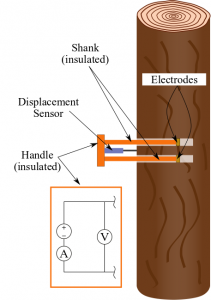
The project at University of Canterbury EPECentre to develop a tool to measure sapwood depth in standing trees has now been completed. ‘Proof of concept’ has been achieved, and a prototype tool developed, which could be used to identify trees with early superior heartwood development. The tool works by recognising that sapwood and heartwood have different electrical conductivity.
A full project report is available here.
(Contributors: Bill Hefferman and Nurzhan Nursultanov)
------------------------------------------------------------------------------------------------------------------------------------------------------------------------------------------------------------------------
Since our last update we have been advised that our 1BT application has been declined by Te Uru Rākau.
Unfortunately we made our application last September under the wider Provincial Growth Fund criteria as our vision is a new regional hardwood industry. The PGF criteria were different to those introduced for the 1BT partnership fund by Te Uru Rākau after the agency was established in November, and, even after re-working, our application was judged to not fit between the new 1BT goalposts. Te Uru Rākau did advise that they will consider a ‘refocused’ 1BT partnership application.
From our perspective this outcome was very disappointing as with PGF/1BT support we could have made planting durable eucalypts a key part of the One Billion Tree programme.
------------------------------------------------------------------------------------------------------------------------------------------------------------------------------------------------------------------------
After 11 years of research we have developed the capability to scale up production of genetically improved nursery stock to commence planting durable eucalypt forests from 2021. There are nurseries ready to start production of XyloGene nursery stock, using best practice techniques, to produce robust and healthy planting stock. However, they need improved seed to start mass production of commercial nursery stock but we still have a lot of work to complete before full commercial deployment of all species is possible.
We also need more resources to expand the extension programme in collaboration with regional council land management teams, Te Uru Rākau, and professional forestry consultants, so that growers will know how to successfully establish durable eucalypts on the right site and manage them to produce high-value hardwoods.
Additional funding is also needed to undertake market research and development, including processing trials, so that growers and processors can better appreciate the significant market opportunity there is for durable hardwoods.
Therefore, we are investigating other funding options to boost investment in our programme. In the meantime the dedicated NZDFI team continues to work hard and make good progress towards our vision of creating a regional durable hardwood industry in New Zealand.
Want to receive future Project Updates?
If you do not already receive our regular Project Updates, you can sign up here.
For more information about any of the work of the NZDFI, contact: info@nzdfi.org.nz
C/- Marlborough Research Centre Trust, PO Box 875, Blenheim 7201